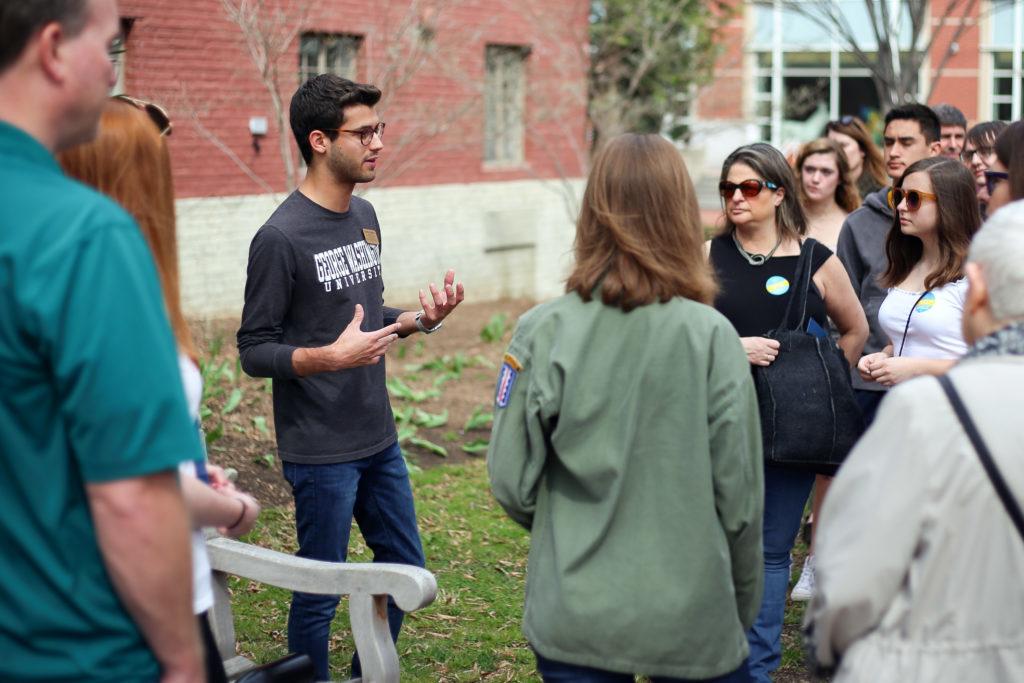Updated: April 3, 2018 at 12:03 a.m.
When accepted students travel to campus this month before making a final admissions decision, officials hope a more intimate introduction to GW will seal the deal.
The University announced last week that rather than hold accepted students events on a few key days, the program will be held every weekday and one Saturday this month, with hard caps on attendance and more academic-focused programming. Experts say the move indicates the University’s desire to give students a more personalized and in-depth preview of campus life, but it could backfire if admitted students come away with an unrealistic perception of the University.
Officials will hold 21 “Inside GW” events over the course of the month, limiting attendance to just 250 students on most days, with 350 students allowed on select Mondays and up to 750 gathering for events on Fridays and the lone Saturday session. Last year, officials welcomed prospective students for five main events, each accommodating a total of about 1,200 people.
“They need to do whatever their customers say and want, so that more students say ‘yes’ to their offer of admission.”
Dean of Undergraduate Admissions Costas Solomou said the changes were based on feedback from last year’s admitted students, who wanted more information about academics at GW in their admissions events. He said keeping the sessions small would create more in-depth conversations between admitted students and GW’s community members.
“We feel that these smaller, more personal events will allow students and their families to get a better sense of GW,” he said in an email. “When you’re in a crowd of 1,500 people, it can be hard to have your questions answered.”
The changes this year come after the program was revamped in 2015 to include more frequent sessions and give prospective students a more upscale experience. Officials were under pressure at the time to increase revenue after graduate enrollment missed projections.
The smaller sessions will enable a “pre-orientation” format where officials will give more information on advising, course registration and student life in students’ prospective majors or programs. Prospective students will also attend hour-long symposiums in the afternoon within their individual schools, featuring faculty panels, mock lectures and school-specific tours.
Mark Montgomery, the president of Great College Advice, a consulting firm for students applying to college, said many universities use a smaller format for accepted students events to give prospective students an impression that the University can give individualized attention to students.
He said universities are also under pressure to attract admitted students to enroll so they can maintain yield rates, the proportion of accepted students who enroll at a university, a metric that is included in ranking systems like U.S. News and World Report.
Last year, GW accepted the most students in at least 13 years to ensure that, with high schoolers applying to more universities than ever, the University would still enroll a large enough freshman class.
“They need to do whatever their customers say and want, so that more students say ‘yes’ to their offer of admission,” Montgomery said.
But he said creating smaller accepted students sessions may create a misleading impression that GW is an intimate university even though it enrolls more than 11,000 undergraduates and more than 25,000 students overall – something that may disappoint students once they arrive on campus.
“The culture expectations, the idea that if you have a gap between what you actually expect and what you actually get, that’s dangerous,” he said.
If current students are criticizing the University for the quality of support services, he said GW should make sure that students are getting the support they need, starting at admitted students days. University President Thomas LeBlanc has made improving student satisfaction a key goal this academic year.
“You can send a message that we care, but what are we doing for the students who are already there?” Montgomery said. “Talk is cheap.”
Jeffrey Yoon, a college consultant, said having smaller groups may allow students to ask questions about something they might not feel comfortable talking about in a large group, like support available for students with learning disabilities.
“Universities don’t want to admit students who don’t want to go.”
“Students may be interested, if they have more questions, to go specifically and ask, especially students if they may have some learning differences, they may not want to ask in a big group,” he said.
Abigail Simkus, a college consultant, founder and director of college consulting firm The College Connection, said a “personal touch” is important to admitted students evaluating universities because they can feel overwhelmed when they are surrounded by so many of their peers.
She said interacting with current students and getting a better sense of academic programs could be more effective in bringing students to GW because it is a chance to showcase the enthusiasm current students have for their programs.
Simkus said educating students in more depth about the University before they enroll could ensure that more students opt to stay on campus until graduation.
In recent years, the University has increased its focus on retention, hiring a specialist in the area in 2016. This January, GW announced that the enrollment and students affairs offices would be merged into the Office of Enrollment and the Student Experience.
“Universities don’t want to admit students who don’t want to go,” she said.
This post was updated to reflect the following correction:
The Hatchet incorrectly reported that 1,200 admitted students attended each session of “Inside GW” events last year. A total of 1,200 students and their families attended those sessions. We regret this error.





